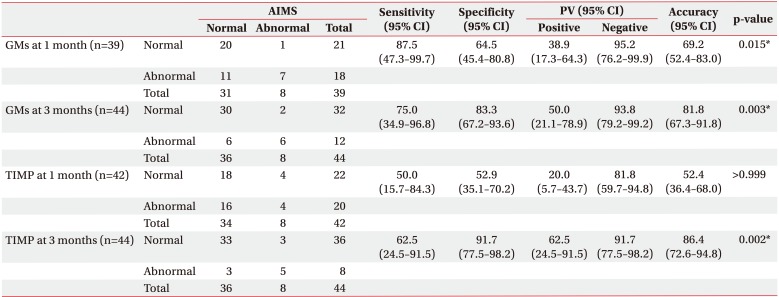1. Bracewell M, Marlow N. Patterns of motor disability in very preterm children. Ment Retard Dev Disabil Res Rev. 2002; 8:241–248. PMID:
12454900.

2. Vaccarino FM, Ment LR. Injury and repair in developing brain. Arch Dis Child Fetal Neonatal Ed. 2004; 89:F190–F192. PMID:
15102716.

3. Wang CJ, McGlynn EA, Brook RH, Leonard CH, Piecuch RE, Hsueh SI, et al. Quality-of-care indicators for the neurodevelopmental follow-up of very low birth weight children: results of an expert panel process. Pediatrics. 2006; 117:2080–2092. PMID:
16740851.

4. Rosenbaum P. Variation and “abnormality”: recognizing the differences. J Pediatr. 2006; 149:593–594. PMID:
17095323.

5. Johnson S, Marlow N. Developmental screen or developmental testing? Early Hum Dev. 2006; 82:173–183. PMID:
16504424.

6. Spittle AJ, Doyle LW, Boyd RN. A systematic review of the clinimetric properties of neuromotor assessments for preterm infants during the first year of life. Dev Med Child Neurol. 2008; 50:254–266. PMID:
18190538.

7. Darrah J, Redfern L, Maguire TO, Beaulne AP, Watt J. Intra-individual stability of rate of gross motor development in full-term infants. Early Hum Dev. 1998; 52:169–179. PMID:
9783818.

8. van Haastert IC, de Vries LS, Helders PJ, Jongmans MJ. Early gross motor development of preterm infants according to the Alberta Infant Motor Scale. J Pediatr. 2006; 149:617–622. PMID:
17095330.

9. Campbell SK, Hedeker D. Validity of the Test of Infant Motor Performance for discriminating among infants with varying risk for poor motor outcome. J Pediatr. 2001; 139:546–551. PMID:
11598602.

10. Campbell SK, Kolobe TH, Osten ET, Lenke M, Girolami GL. Construct validity of the test of infant motor performance. Phys Ther. 1995; 75:585–596. PMID:
7604077.

11. Barbosa VM, Campbell SK, Smith E, Berbaum M. Comparison of test of infant motor performance (TIMP) item responses among children with cerebral palsy, developmental delay, and typical development. Am J Occup Ther. 2005; 59:446–456. PMID:
16124211.

12. Campbell SK, Kolobe TH, Wright BD, Linacre JM. Validity of the Test of Infant Motor Performance for prediction of 6-, 9- and 12-month scores on the Alberta Infant Motor Scale. Dev Med Child Neurol. 2002; 44:263–272. PMID:
11995895.

13. Kolobe TH, Bulanda M, Susman L. Predicting motor outcome at preschool age for infants tested at 7, 30, 60, and 90 days after term age using the Test of Infant Motor Performance. Phys Ther. 2004; 84:1144–1156. PMID:
15563255.

14. Einspieler C, Prechtl H, Bos AF, Ferrari F, Cioni G. Prechtl's method on the qualitative assessment of general movements in preterm, term and young infants. London: Mac Keith Press;2004.
15. Bosanquet M, Copeland L, Ware R, Boyd R. A systematic review of tests to predict cerebral palsy in young children. Dev Med Child Neurol. 2013; 55:418–426. PMID:
23574478.

16. Spittle AJ, Boyd RN, Inder TE, Doyle LW. Predicting motor development in very preterm infants at 12 months’ corrected age: the role of qualitative magnetic resonance imaging and general movements assessments. Pediatrics. 2009; 123:512–517. PMID:
19171616.

17. Sustersic B, Sustar K, Paro-Panjan D. General movements of preterm infants in relation to their motor competence between 5 and 6 years. Eur J Paediatr Neurol. 2012; 16:724–729. PMID:
22727514.

18. Piper MC, Darrah J. Motor assessment of the developing infant. Philadelphia: Saunders;1994.
19. Jeng SF, Yau KI, Chen LC, Hsiao SF. Alberta infant motor scale: reliability and validity when used on preterm infants in Taiwan. Phys Ther. 2000; 80:168–178. PMID:
10654063.

20. Majnemer A, Snider L. A comparison of developmental assessments of the newborn and young infant. Ment Retard Dev Disabil Res Rev. 2005; 11:68–73. PMID:
15856441.

21. Snider L, Majnemer A, Mazer B, Campbell S, Bos AF. Prediction of motor and functional outcomes in infants born preterm assessed at term. Pediatr Phys Ther. 2009; 21:2–11. PMID:
19214070.

22. Snider LM, Majnemer A, Mazer B, Campbell S, Bos AF. A comparison of the general movements assessment with traditional approaches to newborn and infant assessment: concurrent validity. Early Hum Dev. 2008; 84:297–303. PMID:
17766062.

23. Noble Y, Boyd R. Neonatal assessments for the preterm infant up to 4 months corrected age: a systematic review. Dev Med Child Neurol. 2012; 54:129–139. PMID:
22142216.
24. Spittle AJ, Brown NC, Doyle LW, Boyd RN, Hunt RW, Bear M, et al. Quality of general movements is related to white matter pathology in very preterm infants. Pediatrics. 2008; 121:e1184–e1189. PMID:
18390959.

25. Ferrari F, Cioni G, Prechtl HF. Qualitative changes of general movements in preterm infants with brain lesions. Early Hum Dev. 1990; 23:193–231. PMID:
2253580.

26. Barbosa VM, Campbell SK, Sheftel D, Singh J, Beligere N. Longitudinal performance of infants with cerebral palsy on the Test of Infant Motor Performance and on the Alberta Infant Motor Scale. Phys Occup Ther Pediatr. 2003; 23:7–29. PMID:
14664309.






 PDF
PDF ePub
ePub Citation
Citation Print
Print







 XML Download
XML Download